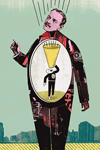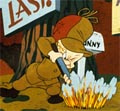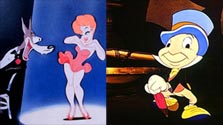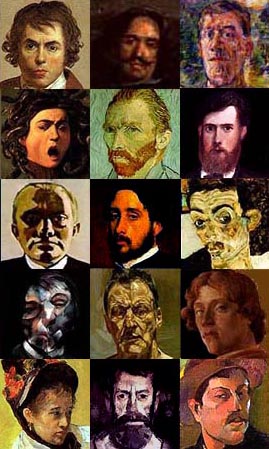




 "Bugs is always provisionally content, satiating his hunger by chewing on his carrot, enjoying a restful life without anxiety or stress. When this is disrupted or challenged, he resists ‘civilising’ processes which do not fit in with the fulfilment of the pleasure principle that his lifestyle represents. Bugs acts to maintain the free-play of his pleasure principle, using his comic capacity as ‘Clown’ to liberate him from inhibition or repression. As an
embodiment of the id, he represents the drives which achieve his particular wishes — anger, the instinct to survive, the enjoyment of sexual freedom (see Chapter Five) etc. " (p. 154, emphasis added)
"Bugs is always provisionally content, satiating his hunger by chewing on his carrot, enjoying a restful life without anxiety or stress. When this is disrupted or challenged, he resists ‘civilising’ processes which do not fit in with the fulfilment of the pleasure principle that his lifestyle represents. Bugs acts to maintain the free-play of his pleasure principle, using his comic capacity as ‘Clown’ to liberate him from inhibition or repression. As an
embodiment of the id, he represents the drives which achieve his particular wishes — anger, the instinct to survive, the enjoyment of sexual freedom (see Chapter Five) etc. " (p. 154, emphasis added) "In many Ways, the ego is the psychic drive that balances the antagonistic tension between the id and the super-ego. Daffy, the Counterfeit, is the embodiment of this tension, oscillating between his desire to achieve power, status, and above all, control, and his collapses into madness through frustration or Weakness. Daffy's ‘ego’ is, indeed, fragile, caught in the perpetual bind of wanting to ‘do the right thing’ but being seduced or distracted from the possibility of achieving it. Daffy tries to think and reason in order to be ‘realistic’ but he is destabilised by the things that happen to him and his irrational response to uncertainty." (p. 155, emphasis added)
"In many Ways, the ego is the psychic drive that balances the antagonistic tension between the id and the super-ego. Daffy, the Counterfeit, is the embodiment of this tension, oscillating between his desire to achieve power, status, and above all, control, and his collapses into madness through frustration or Weakness. Daffy's ‘ego’ is, indeed, fragile, caught in the perpetual bind of wanting to ‘do the right thing’ but being seduced or distracted from the possibility of achieving it. Daffy tries to think and reason in order to be ‘realistic’ but he is destabilised by the things that happen to him and his irrational response to uncertainty." (p. 155, emphasis added) "Elmer Fudd is the closest one gets to a super-ego figure trying to impose himself on the world of nature, but suffering, despite all his attempts to punish transgression in Bugs. His role and function are to contain and restrict, but the very spirit of the cartoon resists the imposition of the super-ego. No matter how much Elmer tries to inhibit Bugs’ pleasures and instincts, his efforts are doomed to failure, because his authority as the embodiment of the super-ego is constantly under question, or plainly ignored. " (p.155, emphasis added)
"Elmer Fudd is the closest one gets to a super-ego figure trying to impose himself on the world of nature, but suffering, despite all his attempts to punish transgression in Bugs. His role and function are to contain and restrict, but the very spirit of the cartoon resists the imposition of the super-ego. No matter how much Elmer tries to inhibit Bugs’ pleasures and instincts, his efforts are doomed to failure, because his authority as the embodiment of the super-ego is constantly under question, or plainly ignored. " (p.155, emphasis added) 
Many intellectuals and philosophers have weighed in on the question with varied opinions, a sampling of which Morris Weitz explores in his article before offering his own answers.
While Plato found absolutely no value in art, claiming that it threatens a life grounded in intellectual rationality by creating falsehoods and dangerous emotions, Tolstoy at least offered differentiation between the uses and misuses of art. Aristotle offers the idea that the arts have the ability to teach us truths concretely, and can relieve us of tensions that could be harmful outside the art world. Plotinus also argues for the importance of art, in that it reminds us “of the presence of soul in matter or…of the creative process in the imagination as it labors over mundane matter” (Weitz, 1976, p. 21, emphasis added).
Connections between these ideas on artistic utility and Freud’s ideas about self-exploration and the alternative (sometimes harmful) manifestations of hidden thoughts and desires are evident. But Freud enters the conversation in a more direct way if we consider his own ideas on the use of art as a form of sublimation: “a kind of substitute gratification of basic libidinal desires we cannot realize in our lives. Art, along with alcohol and religion, is an escape-valve for our bottled up miseries, shared by all who cannot have their civilization without its discontents” (Weitz, 1976, p. 23, emphasis added)
And as Weitz arrives at his own definition of art’s usefulness, one could perhaps draw on Freudian concepts of the psyche in order to more fully understand the author’s claim that “each of the arts in various ways opens up by means of its actualities of visual, verbal, tonal, or emotional and intellectual worlds created by the artist infinite imaginative possibilities of experience and at the same time an awareness of the richness of the texture of actual experience” (Weitz, 1976, p. 23, emphasis added)
 The Influence of Psychoanalysis on Surrealism
The Influence of Psychoanalysis on Surrealism The Development of Self Through Art
The Development of Self Through ArtPaul Sullivan and John McCarthy use case studies of two artists (Mags and Ina) and their art making processes to map out the relationship of self and social influence to activity. More specifically, they examine the role of self in the activity of art making, focusing on aspects of authenticity, reflexivity, self-exploration and formation within an artistic, sociocultural context. The following quotes can be used to connect creative process and product to Freudian ideas of self-development as it relates to social influence, individual perception, and action:
“[Artists] create who they are as part of what they do including the affective, emotional, and cognitive sense they make of what they do. This reciprocity however begs the question, how exactly are we to understand the self and its relationship to activity? Is the self to be seen “in” its action, the author of its action, an object of its action, or all three” (McCarthy & Sullivan, 2007, p. 238)?
“For both Mags and Ina, their participation in art leads to a very full and personal involvement in their selves” (McCarthy & Sullivan, 2007, p. 244).
“[Mags] also mentions pieces in which she sees herself in the work after looking back at them…particularly the kinds of anxieties, worries, or emotions she may have been experiencing at the time…In this way, the work seems to be imprinted by the undercurrent of an emotional, feeling self” (McCarthy & Sullivan, 2007, p. 245).
“[Art making] forces her to confront ultimate truths about herself” (McCarthy & Sullivan, 2007, p. 245).
“Ina points out that [the emergence of personal emotions and feelings] sometimes happens against the will of the artist, that artists sometimes have no choice and no agency when it comes to their feelings and emotions imbuing and flavoring the work” (McCarthy & Sullivan, 2007, p. 246).
“In a way, Ina’s participation in art reflects a struggle between the multiplicity of relationships that can potentially imbue activity” (McCarthy & Sullivan, 2007, p. 246).
